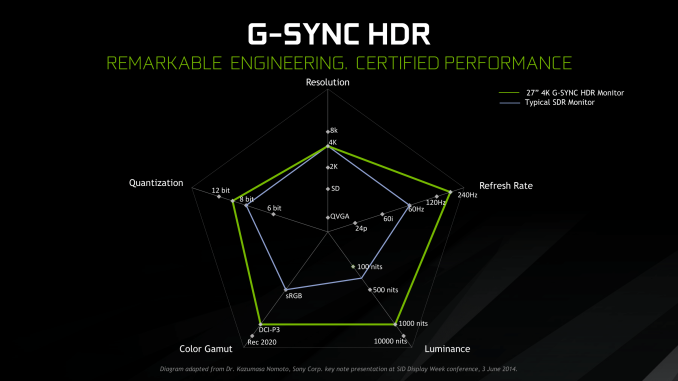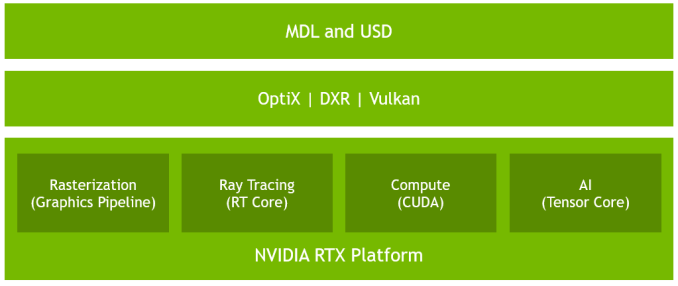The NVIDIA GeForce RTX 2080 Ti & RTX 2080 Founders Edition Review: Foundations For A Ray Traced Future
by Nate Oh on September 19, 2018 5:15 PM EST- Posted in
- GPUs
- Raytrace
- GeForce
- NVIDIA
- DirectX Raytracing
- Turing
- GeForce RTX
Meet The New Future of Gaming: Different Than The Old One
Up until last month, NVIDIA had been pushing a different, more conventional future for gaming and video cards, perhaps best exemplified by their recent launch of 27-in 4K G-Sync HDR monitors, courtesy of Asus and Acer. The specifications and display represented – and still represents – the aspired capabilities of PC gaming graphics: 4K resolution, 144 Hz refresh rate with G-Sync variable refresh, and high-quality HDR. The future was maxing out graphics settings on a game with high visual fidelity, enabling HDR, and rendering at 4K with triple-digit average framerate on a large screen. That target was not achievable by current performance, at least, certainly not by single-GPU cards. In the past, multi-GPU configurations were a stronger option provided that stuttering was not an issue, but recent years have seen both AMD and NVIDIA take a step back from CrossFireX and SLI, respectively.
Particularly with HDR, NVIDIA expressed a qualitative rather than quantitative enhancement in the gaming experience. Faster framerates and higher resolutions were more known quantities, easily demoed and with more intuitive benefits – though in the past there was the perception of 30fps as cinematic, and currently 1080p still remains stubbornly popular – where higher resolution means more possibility for details, higher even framerates meant smoother gameplay and video. Variable refresh rate technology soon followed, resolving the screen-tearing/V-Sync input lag dilemma, though again it took time to catch on to where it is now – nigh mandatory for a higher-end gaming monitor.
For gaming displays, HDR was substantively different than adding graphical details or allowing smoother gameplay and playback, because it meant a new dimension of ‘more possible colors’ and ‘brighter whites and darker blacks’ to gaming. Because HDR capability required support from the entire graphical chain, as well as high-quality HDR monitor and content to fully take advantage, it was harder to showcase. Added to the other aspects of high-end gaming graphics and pending the further development of VR, this was the future on the horizon for GPUs.
But today NVIDIA is switching gears, going to the fundamental way computer graphics are modelled in games today. Of the more realistic rendering processes, light can be emulated as rays that emit from their respective sources, but computing even a subset of the number of rays and their interactions (reflection, refraction, etc.) in a bounded space is so intensive that real time rendering was impossible. But to get the performance needed to render in real time, rasterization essentially boils down 3D objects as 2D representations to simplify the computations, significantly faking the behavior of light.
It’s on real time ray tracing that NVIDIA is staking its claim with GeForce RTX and Turing’s RT Cores. Covered more in-depth in our architecture article, NVIDIA’s real time ray tracing implementation takes all the shortcuts it can get, incorporating select real time ray tracing effects with significant denoising but keeping rasterization for everything else. Unfortunately, this hybrid rendering isn’t orthogonal to the previous concepts. Now, the ultimate experience would be hybrid rendered 4K with HDR support at high, steady, and variable framerates, though GPUs didn’t have enough performance to get to that point under traditional rasterization.
There’s a still a performance cost incurred with real time ray tracing effects, except right now only NVIDIA and developers have a clear idea of what it is. What we can say is that utilizing real time ray tracing effects in games may require sacrificing some or all three of high resolution, ultra high framerates, and HDR. HDR is limited by game support more than anything else. But the first two have arguably minimum performance standards when it comes to modern high-end gaming on PC – anything under 1080p is completely unpalatable, and anything under 30fps or more realistically 45 to 60fps hurts the playability. Variable refresh rate can mitigate the latter and framedrops are temporary, but low resolution is forever.
Ultimately, the real time ray tracing support needs to be implemented by developers via a supporting API like DXR – and many have been working hard on doing so – but currently there is no public timeline of application support for real time ray tracing, Tensor Core accelerated AI features, and Turing advanced shading. The list of games with support for Turing features - collectively called the RTX platform - will be available and updated on NVIDIA's site.













337 Comments
View All Comments
PopinFRESH007 - Thursday, September 20, 2018 - link
You are simply ignoring the facts. When Bluray players launched they didn't play Blurays because there were none, because there was no standard. It took 3 years before there was a standard and 7 movies were released. Before then they were just high-end DVD players.These RTX cards also work out of the box. Its crazy I know, they actually can play current games and all with the highest settings and fastest frame rates. Similar to what happened with bluray, they will also support those new fangled DXR and DLSS options in games as they come out.
imaheadcase - Thursday, September 20, 2018 - link
First Blu-ray movies would be released on June 20, coinciding with the release of the first Blu-ray DVD player from Samsung, and a Sony VAIO Blu-ray PC.Jun 13, 2006The first batch distributed by Sony was on June 20th, 2006:
The Fifth Element
50 First Dates
Hitch
House of Flying Daggers
The Terminator
Underworld: Evolution
xXx
What was that again about facts?
V900 - Thursday, September 20, 2018 - link
Working out of the box? You mean like the RTX 2080/ti/2070 cards?You’re willfully ignoring facts and pretend that it’s totally up in the air whether games will support RTX, and that they won’t be available for a long time...
Which is entirely false.
There are games that support RTX out right now. Like Tomb Raider
More are coming this year: One of the biggest titles this year: Battlefield 5 supports it.
And dozens of titles supporting RTX, many of them big AAA titles, are coming out in H1 2019.
So no: Nobody is buying a card they “can’t even test.” If you buy an RTX card, it’ll work out of the box with RTX technology enabled.
And it’s of course also the fastest card on the market for all the old titles that don’t support RTX.
sonny73n - Thursday, September 20, 2018 - link
@V900If you can’t compare performance per dollar of this gen and the previous, why even bother praising the new tech when currently none of the tech sites have any mean to test them?
After reading your first comment, I couldn’t help but think that you’re a paid shill for Nvidia.
imaheadcase - Thursday, September 20, 2018 - link
You just ignored the facts and even proved yourself wrong in own statement. lolLet me sell you a car with the fastest engine, but i'm not going to let you use all the Horsepower..but i promise i'll enable it when i get the right parts for it. Don't worry about the $100k price tag on the car, its going to be awesome i swear..
Do you get paid for every post by nvidia, or just a lump sum?
mscsniperx - Wednesday, September 19, 2018 - link
You are comparing apples to oranges. There isn't even a raytracing game to compare to.. And when the truth comes out that even with RTX, there is a massive FPS hit.. well, it's game over.DigitalFreak - Wednesday, September 19, 2018 - link
First you complain that there aren't any raytracing games to get benchmarks from, then you state there will be a massive performance hit. If there are no games available to test with, you can't have any idea what their performance will be like.tamalero - Wednesday, September 19, 2018 - link
The slides/demos of Nvidia and the Beta of Battlefield brother..They show performance that could be potentially be "above" what users would expect.
imaheadcase - Wednesday, September 19, 2018 - link
Hello Hairworks would like a word with you..CoachAub - Wednesday, September 19, 2018 - link
Laser discs were a big hit! ;)